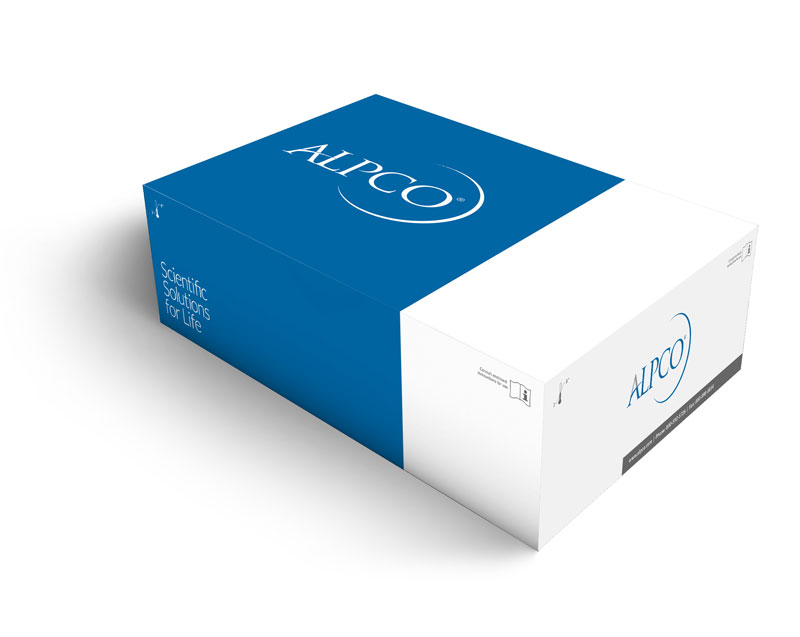-
 Mouse Alpha 1-Antitrypsin ELISA
Mouse Alpha 1-Antitrypsin ELISACatalog #: 41-A1AMS-E01
Sensitivity: 6.25 ng/mL
Range: 6.25 - 200 ng/mL
Sample Types: Serum
Sample Size(s): 96 Wells
Detection: Colorimetric -
 Rat Alpha 2 Macroglobulin ELISA
Rat Alpha 2 Macroglobulin ELISACatalog #: 41-A2MRT-E01
Sensitivity: 6.24 ng/mL
Range: 6.25 - 400 ng/mL
Sample Types: Plasma, Serum
Sample Size(s): 96 Wells
Detection: Colorimetric -
 Alpha 1-Antichymotrypsin ELISA
Alpha 1-Antichymotrypsin ELISACatalog #: 41-A1CHU-E01
Sensitivity: 6.25 ng/mL
Range: 6.25-400 ng/mL
Sample Types: Plasma, Serum
Sample Size(s): 96 Wells
Detection: Colorimetric -
 Alpha 1 Microglobulin ELISA
Alpha 1 Microglobulin ELISACatalog #: 30-6710
Sensitivity: 0.006 mg/L
Range: 0.019 - 1.5 mg/L
Sample Types: Plasma, Serum, Urine
Sample Size(s): 96 Wells
Detection: Colorimetric -
 Rat Alpha 1 Acid Glycoprotein ELISA
Rat Alpha 1 Acid Glycoprotein ELISACatalog #: 41-AGPRT-E01
Sensitivity: 12.5 ng/mL
Range: 12.5 - 400 ng/mL
Sample Types: Plasma, Serum
Sample Size(s): 96 Wells
Detection: Colorimetric -
 Anti-TNF alpha Inhibitor ELISA (antibody against ENBREL®)
Anti-TNF alpha Inhibitor ELISA (antibody against ENBREL®)Catalog #: 30-9653
Sensitivity: Cut-off
Range: Cut-off
Sample Types: Serum
Sample Size(s): 96 Wells
Detection: Colorimetric -
 Alpha MSH RIA
Alpha MSH RIACatalog #: 38-RB303RUO
Sensitivity: 3 pmol/L
Range: 4.7 - 150 pmol/L
Sample Types: Cerebrospinal Fluid, Plasma
Sample Size(s): 100 Tubes
Detection: I-125 -
 Alpha 1-Acid Glycoprotein ELISA
Alpha 1-Acid Glycoprotein ELISACatalog #: 41-AGPHU-E01
Sensitivity: 5 ng/mL
Range: 5-320 ng/mL
Sample Types: Plasma, Serum
Sample Size(s): 96 Wells
Detection: Colorimetric -
 Alpha Fodrin Check IgG/IgA ELISA
Alpha Fodrin Check IgG/IgA ELISACatalog #: 35-AFCHU-E01
Sensitivity: 1.0 U/mL
Range: 3 - 300 U/mL
Sample Types: Serum
Sample Size(s): 96 Wells
Detection: Colorimetric -
 Chicken Alpha 1-Acid Glycoprotein ELISA
Chicken Alpha 1-Acid Glycoprotein ELISACatalog #: 41-AGPCH-E01
Sensitivity: 6.25 ng/mL
Range: 6.25-200 ng/mL
Sample Types: Plasma, Serum
Sample Size(s): 96 Wells
Detection: Colorimetric -
 Alpha 1 Antitrypsin ELISA (Clearance)
Alpha 1 Antitrypsin ELISA (Clearance)Catalog #: 30-6752
Sensitivity: 1.8 mg/dl
Range: 3.3 - 90 µg/L
Sample Types: Plasma, Serum, Stool
Sample Size(s): 96 Wells
Detection: Colorimetric -
 Mouse Haptoglobin ELISA
Mouse Haptoglobin ELISACatalog #: 41-HAPMS-E01
Sensitivity: 5 ng/mL
Range: 7.81 - 125 ng/mL
Sample Types: Plasma, Serum
Sample Size(s): 96 Wells
Detection: Colorimetric
